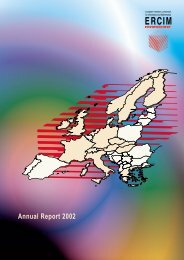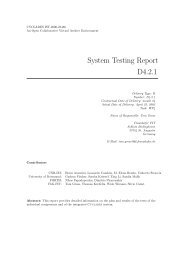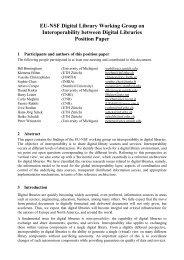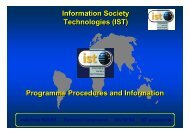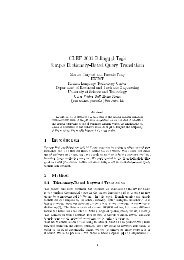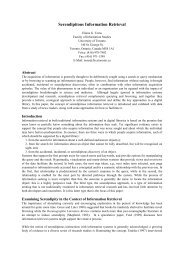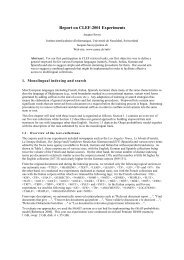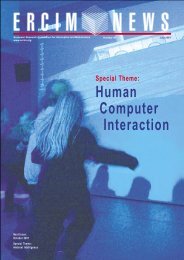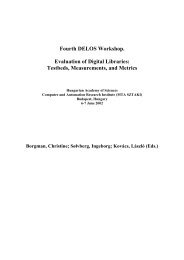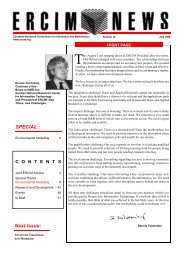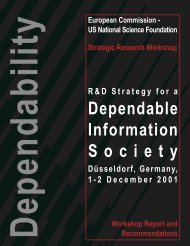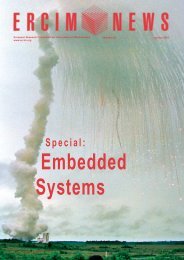Towards a Platform for Widespread Embedded Intelligence - ERCIM
Towards a Platform for Widespread Embedded Intelligence - ERCIM
Towards a Platform for Widespread Embedded Intelligence - ERCIM
Create successful ePaper yourself
Turn your PDF publications into a flip-book with our unique Google optimized e-Paper software.
ISTI-CNR - Donatella Castelli coordinated the first Digital<br />
Library Reference Model workshop in Frascati, near Rome,<br />
in June. At the workshop, an<br />
invited group of international<br />
experts discussed the digital<br />
library (DL) model proposed<br />
by DELOS, the Network of<br />
Excellence on Digital<br />
Libraries. Despite the large<br />
number of digital library systems<br />
in existence, there is so far<br />
no clear agreement on what<br />
these systems are exactly, nor<br />
what basic functionality they<br />
should provide. This model is a<br />
first attempt at establishing an<br />
abstract DL framework, based<br />
Donatella Castelli.<br />
CWI - Christine Bachoc, Université Bordeaux, and Frank<br />
Vallentin, CWI, have found new upper bounds <strong>for</strong> 'kissing'<br />
in higher dimensions.<br />
In geometry the kissing<br />
number is the maximum<br />
number of nonoverlapping<br />
unit balls<br />
that can simultaneously<br />
touch a central unit ball.<br />
In two dimensions the<br />
kissing number is six.<br />
This can be seen when<br />
euro coins are grouped<br />
around one central euro<br />
coin (see picture). The<br />
kissing number is only<br />
known <strong>for</strong> the dimen-<br />
sions 1, 2, 3, 4, 8 and 24. For the dimensions 5, 6, 7, 9 and 10<br />
Bachoc and Vallentin now found sharper upper bounds. The<br />
kissing problem has a rich history. In 1694 Isaac Newton and<br />
David Gregory had a famous discussion about the kissing<br />
number in three dimensions. Gregory thought thirteen balls<br />
could fit while Newton believed the limit was twelve. Only in<br />
1953, Schütte and Van der Waerden proved Newton right.<br />
An article explaining the results is available at<br />
http://arxiv.org/abs/math.MG/0608426.<br />
on a small number of unifying<br />
concepts. It seeks to provide a<br />
common semantics that can be<br />
used across different DL implementations. The workshop<br />
aimed at achieving global consensus on this model. In her<br />
introductory speech, Patricia Manson, Head of the EC unit <strong>for</strong><br />
'Technology-Enhanced Learning & Cultural Heritage' said that<br />
she expected that the results of the workshop would impact on<br />
the definition of FP7 research priorities and help to initiate the<br />
relevant political and operational actions needed to deliver the<br />
European Digital Library to European citizens.<br />
Kissing coins.<br />
IN BRIEF<br />
Fraunhofer-Gesellschaft - Ulrich Trottenberg took over the<br />
presidency of the 'Fraunhofer Center of Institutes', Schloss<br />
Birlinghoven, on 1st July 2006. The 'center of institutes Schloss<br />
Birlinghoven' gathers all research institutes at the Birlinghoven<br />
campus. With some 500 scientists, it is the largest center <strong>for</strong><br />
in<strong>for</strong>mation technology of the Fraunhofer Gesellschaft. During<br />
his presidency Trottenberg<br />
intends to make the leading role<br />
of the institute center more visible.<br />
He is planning to do this<br />
by numerous events/meetings<br />
<strong>for</strong> industry, research, politics<br />
and the general public.<br />
Ulrich Trottenberg holds the<br />
chair <strong>for</strong> Applied Mathematics<br />
and Scientific Computing at the<br />
Department <strong>for</strong> Mathematics at<br />
the University of Cologne. He<br />
also is the head of the<br />
Fraunhofer Institute <strong>for</strong><br />
Algorithms and Scientific<br />
Computing (SCAI) and vice<br />
chairman of the Fraunhofer<br />
Research Group <strong>for</strong> In<strong>for</strong>mation<br />
and Communication<br />
Ulrich Trottenberg.<br />
Technology (ICT). In addition he heads the Department of<br />
Simulation and Software Technology of the German<br />
Aerospace Center.<br />
Current research topics of the Fraunhofer Center of Institutes<br />
are the extension of the world-wide web to in<strong>for</strong>mation technology<br />
services, the handling of the data flood with automatic<br />
extraction of knowledge from data (datamining) and Human-<br />
Machine Interaction.<br />
A team of researchers from the Politecnico di Milano and<br />
CEFREIL Labs, led by Stefano Ceri, won the 2006 Semantic<br />
Web Services Challenge (SWS), organised by Stan<strong>for</strong>d<br />
University. The goal of the SWS Challenge is to develop a<br />
common understanding of various<br />
technologies intended to<br />
facilitate the automation of<br />
mediation, choreography and<br />
discovery <strong>for</strong> Web Services<br />
using semantic annotations.<br />
The challenge required the<br />
solution of a Web Service<br />
mediation problem and a Web<br />
Service discovery problem.<br />
The implementation presented<br />
by the Italian team was judged<br />
the most complete.<br />
See:<br />
http://deri.stan<strong>for</strong>d.edu/challenge/2006/<br />
Stefano Ceri.<br />
<strong>ERCIM</strong> News No. 67, October 2006<br />
75



